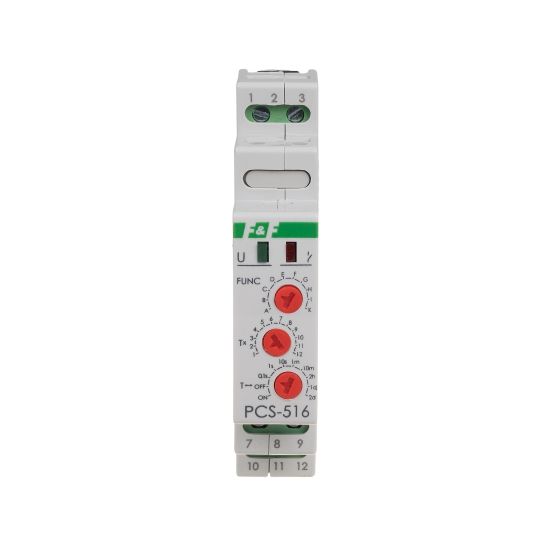





Functioning
The relay realizes the selected function of work in accordance with the set time regime. The selection of a specific time range and the function of the relay operation consists in setting the appropriate combination of rotary coding switches.
Features of relays in the AC version:
* Semiconductor output (triac) for controlling loads supplied with AC voltage
* Switching on the load at zero voltage, turning off at zero power - low stroke when switching on
* No problems with the wear of the relay contacts - dedicated to work with a high switching frequency
* Output separated from the input - you can power / control one phase, and the receiver can be connected to another phase
Functions
DELAYED ON
After applying the supply voltage (U green LED is on), the output remains open and the set operating time "t" is measured. After measuring the time "t", the output switches on (red LED is on). Re-execution of the relay operation mode is possible after disconnecting the supply voltage and switching it on again.

DELAYED OFF
Until the relay is switched on, the output remains open. After applying the supply voltage (green LED is lit) the output will be closed
and the set operating time "t" is measured (red LED illuminated). Re-execution of the relay operation mode is possible after disconnecting the supply voltage and switching it on again.

DELAYED ON - CYCLIC
The mode of operation of the delayed switching is carried out cyclically at equal intervals of the set working time and break.

DELAYED OFF - CYCLIC
The mode of operation of the delayed switching off is carried out cyclically at equal intervals of the set working time and break.

a pulse of 0.5 s after a set time "t".

Generation of a single pulse with time "t" on the rising edge of the START signal. During the timing, the system does not respond to START pulses.

Generation of a single pulse with time "t" on the falling edge of the START signal. During the timing, the system does not respond to START pulses.

Delay on switching off with the possibility of sustaining. The rising edge of the START signal causes the relay to be activated, while the falling edge causes the timing to start. Entering the START signal during timing causes the cycle to be extended by another time "t" with a falling edge.

Generation of a single pulse 0.5 s after the time "t" triggered by the falling edge of the START signal.

Turning off the relay for a specific time "t" with the rising edge of the START signal. During the timing, the system does not respond to the START signal.
Attention!
* Providing the RESET voltage during the function execution causes:
- for the functions A, B, C, D, F, the implementation of the operating mode from the beginning.
- for the F, G, H, I functions, return of the relay to the initial state and waiting for the START signal.
- for K function, permanent contact of the relay in position 11-12.
* Setting the rotary switch of the time range in position:
* When the power is turned on, the system does not react to changing the time range settings.
* Work with the newly set time range occurs after switching off and restarting the power supply.
* With the power supply switched on within the set time range, it is possible to smoothly adjust the time in the range of the time setting value.